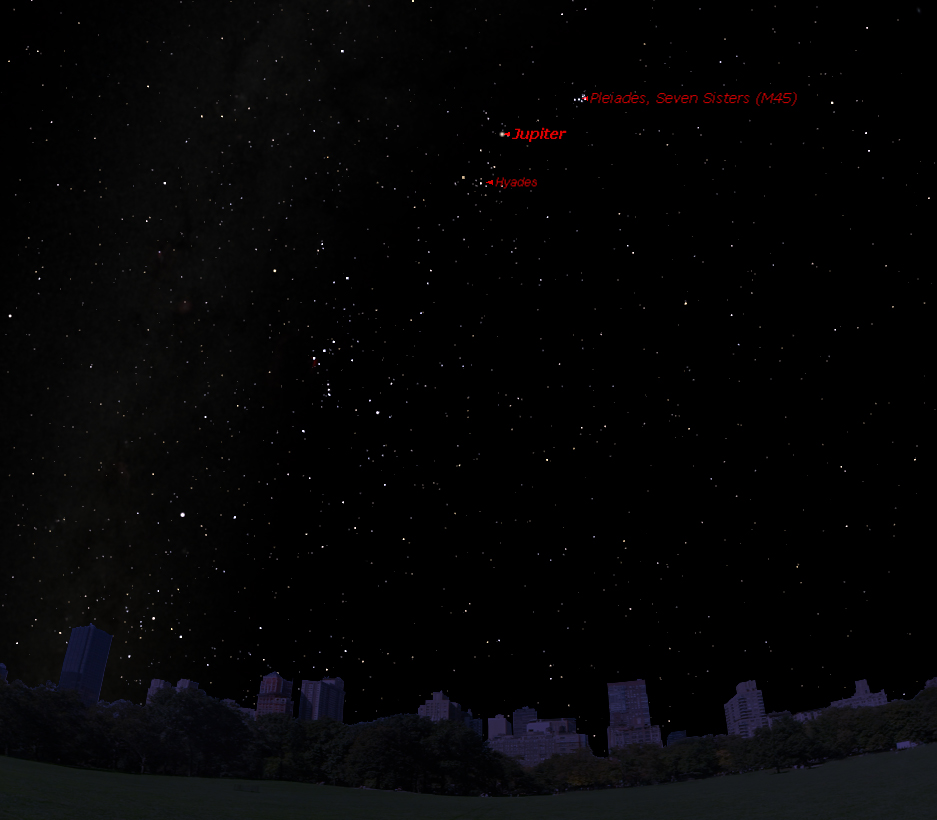
With the moon reaching new phase today (Jan. 11), leaving the sky extremely dark, this upcoming week will be an ideal time to get out your binoculars and explore the profusion of star clusters now evident in our evening sky.
Such clusters represent aggregations of young, recently born stars. They are in our galaxy's local spiral arm, into whose interior we are looking at this time of year. These stars condensed out of the interstellar gas in this part of the Milky Way.
Two of the very best are high in our evening sky and toward the south at around 9 p.m. local time now. You can easily locate them by using the famous three-star belt of Orion, the Mighty Hunter. Extending an imaginary line from the belt, upward and to the right will take you to the clusters of the Hyades and Pleiades of the constellation Taurus, the Bull.
And as a bonus this winter, shining right in between these two star clusters is brilliant Jupiter, shining like a steady, silvery beacon high in the south. You can't miss it. [Night Sky Stargazing Guide: January 2013 (Sky Maps)]
Interestingly, Australian aborigines believed that the three belt stars of Orion were three young men dancing to the music played by nearby maidens (the Pleiades). And indeed, the most beautiful and famous star cluster in the night sky is the Pleiades.
Why Seven Sisters?
The traditional Greek legend for the Seven Sisters, as this cluster has long been known, is that they are the daughters of Atlas and Pleione. Their father, Atlas, rebelled against Zeus, the king of the gods, who retaliated by sentencing him to forever holding up the heavens on his shoulders. This so grieved the sisters that Zeus placed them in the heavens so that they could be close to their father.
Get the Space.com Newsletter
Breaking space news, the latest updates on rocket launches, skywatching events and more!
To the average eye, this group looks at first like a shimmering little cloud of light. But further examination, aided by good eyesight, will reveal a tight knot of tiny stars.Interestingly, widely separated and totally different cultures have always described the Pleiades as the "Seven Sisters," "Seven Maidens," or "Seven Little Girls." Yet only six stars are readily visible to most. Some with more acute vision can count many more.
One person, who has claimed to have seen as many as 19 Pleiades with his unaided eyes while observing under pristinely dark skies from rural Arizona, is Allen Seltzer, who three decades ago served as education director at New York's Hayden Planetarium. Seltzer is blessed with unusually keen vision, which he once demonstrated to me by reading a page from The New York Times from across a nearly 20-foot room.
But why this cluster has been cited by more than one early culture as having seven members remains a mystery.
About 250 stars have been identified as members of this cluster. Gaze at them through binoculars: The brightest stars glitter like an array of icy blue diamonds on black velvet. Or as Alfred, Lord Tennyson wrote, they "Glitter like a swarm of fireflies tangled in a silver braid."
Several stars in the cluster seem to be enveloped in clouds of dust, perhaps left over from the stuff of which they were formed. About 410 light-years away and some 20 light-years across, the group may be no older than 20 million years.
V-shape face
The Pleiades cluster is in the Bull's shoulder. The Bull's face is plainly marked by the fine V-shape cluster of the Hyades.
Notice the bright orange star at the end of the lower arm of the V, which represents the Bull's fiery eye. That's Aldebaran, "the follower;" it rises soon after the Pleiades and pursues them across the sky.
Aldebaran ranks as the 13th brightest star in the sky, but this winter, compared to nearby Jupiter, it shines only 1/27 as bright; maybe think of Jupiter as a general and Aldebaran as his lieutenant.
The Hyades are among the nearest of the star clusters, which explains why so many of the separate stars can be readily seen. At a distance of 130 light-years, the Hyades members travel through space like a flock of geese, their paths ultimately converging toward a point between the stars Betelgeuse in Orion and Procyon in Canis Minor, while receding from us at the rate of 100,000 miles per hour (160,000 kilometers per hour).
Aldebaran, on the other hand, is just an innocent bystander that does not belong at all to the Hyades and is moving toward the south almost at right angles to the cluster's motion and twice as fast. At 65 light-years away, Aldebaran is half the distance of the Hyades. Taurus's V-shape head is, therefore, going to pieces. For 25,000 years or more it will pass for a V, but after 50,000 years it will be quite out of shape.
Joe Rao serves as an instructor and guest lecturer at New York's Hayden Planetarium. He writes about astronomy for The New York Times and other publications, and he is also an on-camera meteorologist for News 12 Westchester, New York. Astronomer Geoff Gaherty of Starry Night Education contributed to this report.
Join our Space Forums to keep talking space on the latest missions, night sky and more! And if you have a news tip, correction or comment, let us know at: community@space.com.

Joe Rao is Space.com's skywatching columnist, as well as a veteran meteorologist and eclipse chaser who also serves as an instructor and guest lecturer at New York's Hayden Planetarium. He writes about astronomy for Natural History magazine, Sky & Telescope and other publications. Joe is an 8-time Emmy-nominated meteorologist who served the Putnam Valley region of New York for over 21 years. You can find him on Twitter and YouTube tracking lunar and solar eclipses, meteor showers and more. To find out Joe's latest project, visit him on Twitter.









